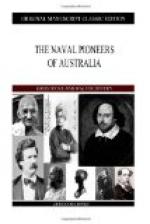“The charts with which I compared such parts of this coast as I visited are bound up with a French work entitled Histoire des Navigations aux Terres Australes, which was published in 1756, and I found them tolerably exact.”
As to what Cook did in the matter of dry geographical details, if the reader wants them he must go to one or other of the hundred or more books on the subject. In a few words, he sailed between the two main islands of New Zealand, discovering for himself the existence of the straits separating them. He first saw the south-east coast of New Holland at Point Hicks, named by him after his first lieutenant, and now called Cape Everard, in the colony of Victoria; from here he ran north to Botany Bay, where he anchored, took in water and wood, and buried a sailor named Forby Sutherland, who died of consumption and whose name was given to the southern headland of the bay. It is worth noting that in every original document relating to this voyage, save one chart, this bay is called Stingray Bay, after, as Cook himself says, the great number of stingrays caught in it. In one chart, in Cook’s own writing, the name Botany Bay is given; but all the Endeavour logs call it Stingray Bay, and the name Botany Bay was probably an afterthought.
From here Cook coasted north, marking almost every point and inlet with such accuracy and such minuteness as fully justifies in its particular meaning the statement that Cook discovered and surveyed the whole of the eastern coast of Australia. He then sailed through Torres Straits, proving that New Guinea was a separate island, and thence made his way to Batavia.
Before leaving the coast he landed on August 21st on Possession Island, which lies about a couple of miles off the western shore of the Cape York peninsula, and there formally took possession of the continent, observing the usual ceremony of hoisting the colours and firing a volley. According to Hawkesworth, Cook took possession of the country, and named it New South Wales. There is no evidence whatever of this, and Hawkesworth himself was probably the first person to write the name. In none of the official log-books or other documents does any other name than New Holland occur, and until Flinders suggested the name “Australia,” “New Holland” was the generally accepted title of the continent.
Another remarkable mis-statement, which is believed by many, relates to the discovery and naming of Port Jackson, the port of Sydney. On Sunday, May 6th, 1770, Cook’s official log contains this entry:—
“Abrest of an open bay;
dist. off the nearest shore, two or three
miles. Lat’d. obs.,
33 degrees 47.
“At this time (noon)
we were between two or three miles distant
from the land, and abrest
of a bay or harbour, in which there
appeared to be a good anchorage,
and which I called Port Jackson.”




